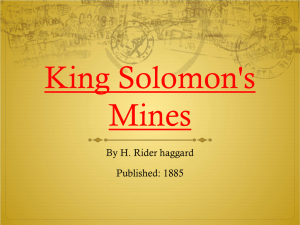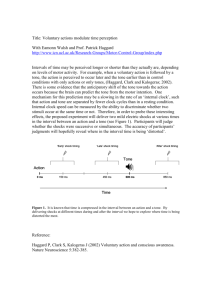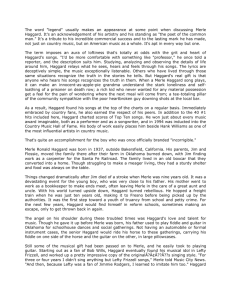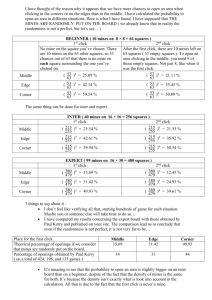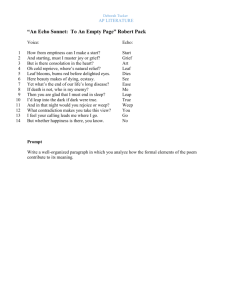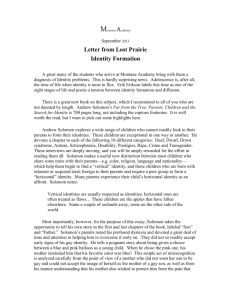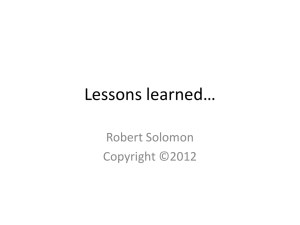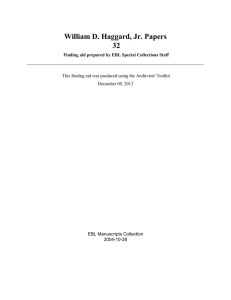King Solomon´s Mines - Universität Bamberg
advertisement
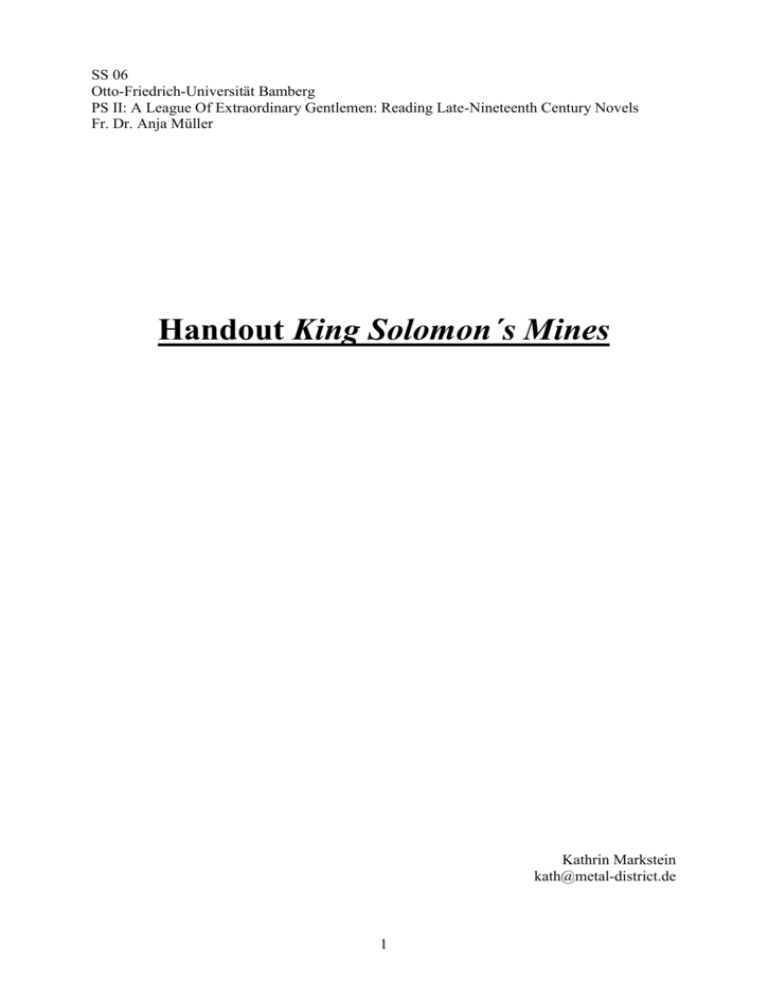
SS 06 Otto-Friedrich-Universität Bamberg PS II: A League Of Extraordinary Gentlemen: Reading Late-Nineteenth Century Novels Fr. Dr. Anja Müller Handout King Solomon´s Mines Kathrin Markstein kath@metal-district.de 1 Sir Henry Rider Haggard – King Solomon´s Mines (1885) About the author born in Norfolk, 1856 went to Natal/Africa at the age of 19 as a secretary to the Governor of Natal colony was appointed Master and Registrar of the High Court of the Transvaal at the age of 21 got acquainted with Zulu culture admired the Zulu warriors armed clashed between black natives and white colonialists in Africa Haggard returned to England in 1879 and married Louisa Margitson returned to Transvaal in 1880 to farm ostriches but Transvaal was into rebellion, and armed Boers attacked farmhouses Haggard and his family returned to England where he started writing wrote over 40 books (fiction and non-fiction), several articles etc. bet with his brother whether Haggard could write anything as good as Treasure Island wrote an adventure for boys on his own King Solomon´s Mines was knighted in 1912 became Knight Commander of the British Empire in 1919 died in London, 1925 not only a writer but also a faithful servant of the British Empire Important works Non-fiction Cetywayo and His White Neighbours (1896) Fiction King Solomon´s Mines (1885) She (1887) Allan Quatermain (1887) Cleopatra (1889) Nada The Lily (1892) Ayesha. The Return Of She (1905) Allan And The Ice Gods (1927) I. Characters 1. Allan Quatermain fictional narrator of the story, occurs in Haggard's later works cf. Allan Quatermain and Allan Quatermain´s Wife “amateur anthropologist relying on his inside knowledge of various African tribes to make contrasts and value-judgements about tribal customs as a means to place and rank social groups” (Stott, 103) 2 Older than his companions: represents the old generation of settler-colonial mercantilism whereas Good and Curtis stand for the generation of metropolitan imperial capital feminized: cowardly, obsequious, bashful Haggard created him as unlike as himself as possible 2. Captain John Good transformed in the course of the story: becomes a very unlikely sex-symbol feminized: he is very much the “stereotypical English maiden” (Fraser, 34) 3. Sir Henry Curtis physically perfect his impressive appearance has the effect of feminizing his two companions equals Umpoba in physical stature but they are divided by race, rank and language in creating Curtis and Good, Haggard criticizes the dispersion of metropolitan power II. Imperialism Haggard is sometimes accused of racism: but “race” is not central in his novels, rather: the question of legitimation (historical, political, aesthetic) attributes the ruins and stone carvings in King Solomon's Mines to an ancient white culture, probably the Phoenicians wants to validate the British presence in Africa: an ancient, foreign civilization had once established itself there, i.e., Britain could do likewise thinks that “the production of wealth is being controlled by the wrong classes of an international bourgeoisie” (Chrisman b, 30) Quatermain rediscovers gold as an ancient industry and so removes it from the contemporary power structure: associates it with the 'legitimate' class (represented by his trio) Britain depends on the labour of the African people, they are an instrument for the British (cf. Foulata and Gagool) Haggard calls attention to fundamental ideological contradictions III. Feminization Of Africa lack of a central female figure in King Solomon´s Mines (as opposed to She) story free from women, but Africa = (white) female body treasure map forms an image of a headless female body (they have to travel through Sheba's Breasts, down Solomon's Road to a triangle of mountains, where they descend into a pit) Sheba's Breasts: trio almost dies of starvation beside “the primary source of sustenance, the breast” (Stott, 93) reader becomes aware of the cruelty of African landscape the unknown Africa is like a female body, promises to be taken and full of dangers: “the male must dare to travel into foreign territory and must risk being consumed by this new terrain” (Stott, 125) emphasises the dangers of the quest: persistent fear about what will be found once the centre (the mines) is reached and the veil lifted (veil on the mysteries of woman and mysteries of Africa, the unknown) Africa = Femme Fatale: trio almost dies in the mines “manhood will be confirmed of forever lost” (Stott, 118): they must escape the object of their quest 3 IV. Genre 1. Imperial Romance Romance contains a quest: Quatermain, Curtis and Good trek to the unknown interior in search of Curtis's lost brother where their moral and physical strength is tested non-realistic to make his romance become more realistic, Haggard uses science like geography, archaeology and even biblical images (the mines as the biblical Ophir) King Solomon's Mines as a contemporary response to imperial capitalism Haggard´s romances became very popular and attracted many settlers to South Africa 2. Male Novel “Written by men for men or boys and about the activities of man” (Stott, 90) The male novel as a countermovement to the Victorian novel with women Bibliography 1. Chrisman, Laura. “Manufacturing Mystery from Mining: King Solomon´s Mines I).” Rereading the Imperial Romance: British Imperialism and African Resistance in Haggard, Schreiner, and Plaatje. Oxford: Clarendon, 2000. 23-46 2. Chrisman, Laura. “Trading On Africa: King Solomon´s Mines (2).” Rereading the Imperial Romance: British Imperialism and African Resistance in Haggard, Schreiner, and Plaatje. Oxford: Clarendon, 2000. 47-73 3. Fraser, Robert. “Rider Haggard´s African Romances.” Victorian Quest Romance. Ed. Robert Fraser. Plymouth: Northcote House, 1998. 28-46 4. Katz, Wendy R. Rider Haggard and the Fiction of Empire: A Critical Study of British Imperial Fiction. Cambridge: Cambridge UP, 1987. 5. Sandison, Alan. “Rider Haggard: ´Some Call it Evolution…´” The Wheel Of Empire: A Study Of The Imperial Idea in some Late Nineteenth and Early Twentieth Century Fiction. London: Macmillan, 1967. 25-47 6. Stiebel, Lindy. “Creating A Landscape Of Africa: Baines, Haggard and Great Zimbabwe”.” English in Africa 28 (2001): 123-133. 7. Stott, Rebecca. “Rider Haggard´s Black Widow.” The Fabrication of the LateVictorian Femme Fatale: The Kiss Of Death. Basingstoke: Macmillan, 1992. 88-125 4
